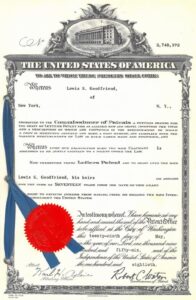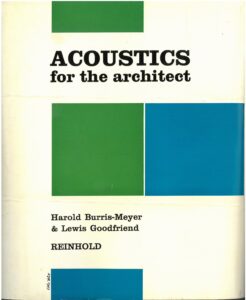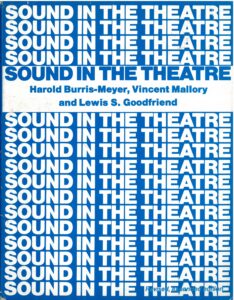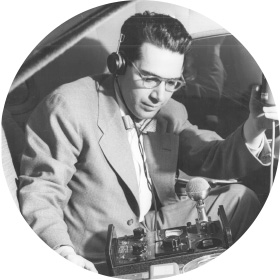100th Anniversary of the Birth of Lew Goodfriend
In 2023 we celebrated the 100th birthday of our company’s late founder, Lewis S. Goodfriend. Lew had an extraordinary career in acoustical engineering spanning eight decades, from his research at Stevens Institute of Technology in the 1940s to his retirement in 2014. From our archives, we assembled a variety of Lew’s editorials from his time as Editor of Noise Control and Sound and Vibration magazines, and articles he wrote for other publications dating back to 1948. Lew authored two books with Harold Burris-Meyer, Acoustics for the Architect (1957) and Sound in the Theater (1979), and wrote over 60 articles, editorials, and book reviews in professional publications. He also held a patent for a Reverberation Generator (No. 2,748,192). In 2001, Rich Peppin interviewed Lew on his life and work, the transcript of which is now part of Niels Bohr Library & Archives of the American Institute of Physics.
Current President Matt Murello and Associate Principal Jack Zybura had the pleasure of working with Lew for many years and are proud to carry on his legacy through the company.
Interview for the American Institute of Physics
Lew was a Fellow of the Acoustical Society of America and the Audio Engineering Society, a Founder, Past President, and Fellow of the Institute of Noise Control Engineering, a Senior Member of the Institute of Electrical and Electronics Engineers, and a Member of the Consulting Engineers Council, the American Industrial Hygiene Association, and ASTM International, and served on the Board of Trustees of Stevens Institute of Technology. He received his M.E. degree from Stevens Institute of Technology in 1947 and his M.E.E. degree from Polytechnic Institute of Brooklyn in 1952. He was a registered Professional Engineer in New York, New Jersey, Michigan, Wisconsin, and California, and was Board Certified by the Institute of Noise Control Engineering.
A Brief Personal History
by Lewis S. Goodfriend
14 August 2011
I was born in New York City on 21 May 1923. My parents and sister were living in Larchmont, New York at the time, but my parents shortly bought the house at 112 Walworth Avenue in Scarsdale that I grew up in. I do not remember my years before kindergarten. I went to the Greenacres Elementary School where I was an average student. I showed an early interest in taking photographs and as a 12-year-old I built my first crystal radio. I was fascinated by the phenomenon of radio, the idea that one could listen to someone far away – like 5 miles – with no wires, and wanted to build a short-wave radio which I later did, so I could hear people from faraway places like Europe and South America. Then I heard a ham radio operator a few miles away talking to other ham operators in England and I was hooked. I rode my bicycle to his house, and he took me to his radio room and showed me his rack full of equipment, and I wanted to know more and to be a ham radio operator too.
I was also loaned a Graflex camera and later a 35 mm Zeiss Contax camera by the service manager, when I was in high school and learned how to take sports action photographs and candid pictures around the school that were used in the school yearbooks. I also became interested in sound, disc recording and for several years, while in high school, I rented a public address system for public functions like the ceremonies at the high school field on Memorial Day.
I entered Stevens Institute of Technology in 1940 and immediately became involved in the experimental theater and the use of sound in theatrical presentations working under Professor Harold Burris-Meyer. In 1941, I spent the summer working on a National Defense Research project at Stevens and in November 1941 quit college to work full time on the research project. The project dealt with the applications of high intensity sound, speech transmission from an aircraft flying at 5000 ft, and applications of battle sounds to deceptive warfare.
In May of 1943, I left the research project to enlist in the U.S. Marine Corps joining a unit, called the Beach Jumpers, that I had helped train in the applications of battle sounds. After two years of duty in the South Pacific participating in the recapture of Guam and the invasion of Okinawa, I returned to Stevens and was awarded the degree Mechanical Engineer in 1947. For the next three years I continued on the sound research staff at Stevens. Among my activities was the design of a high intensity ultrasonic source designing, building the power supply and converting a WWII high-frequency aircraft radio transmitter for a signal source, and designing a quartz piezoelectric, crystal transducer and matching transformer to provide high frequency sound in a fluid bath that could be used to irradiate mechanical samples.
During 1950-51, I worked full time in the graduate program at Polytechnic Institute of Brooklyn, receiving the degree Master of Electrical Engineering in 1952. My master’s thesis covered the design of a synthetic reverberation generator that used a magnetic tape loop with multiple pickup heads and a summing circuit that added the output with the input signal at a controllable level in order to decrease the time between “reflections.” During this period, I was also working part-time at the Audio Instrument Company and in 1952 became chief Electrical Engineer. At the Audio Instrument Company, I redesigned several instruments for production and designed the company’s high-power linear amplifier that would drive a conventional pen recorder at high speed based on the company’s logarithmic converter circuitry.
While on the staff at Stevens in 1947, I prepared a number of articles for Audio Engineering Magazine and participated in the formation of the Audio Engineering Society. During 1953 I served as the first editor of the Journal of the Audio Engineering Society and from 1954 to 1957 I served as editor of the Magazine, Noise Control, published by the Acoustical Society of America. Also in 1953, at the end of the Korean war, I established an acoustical engineering firm serving architects, engineers and industrial concerns in the northeast in the areas of electroacoustics and architectural acoustics.




